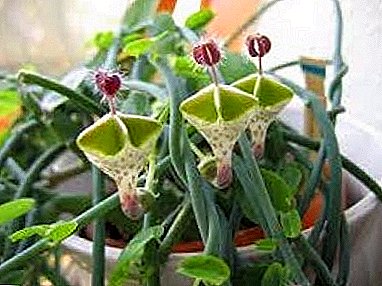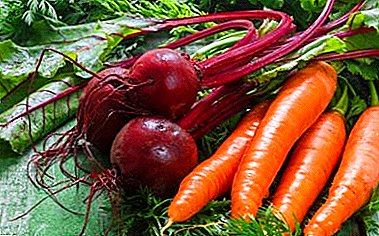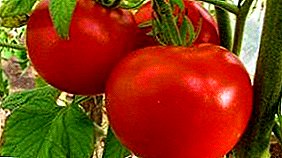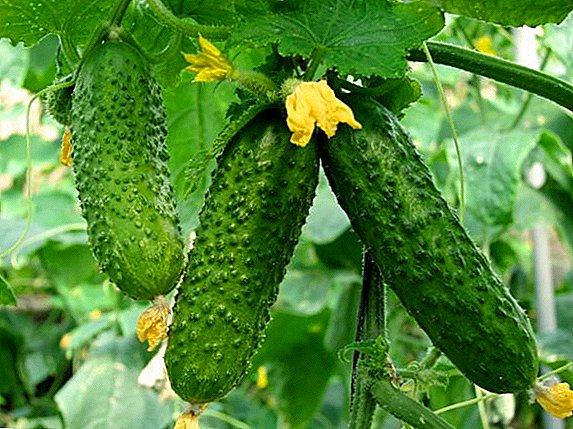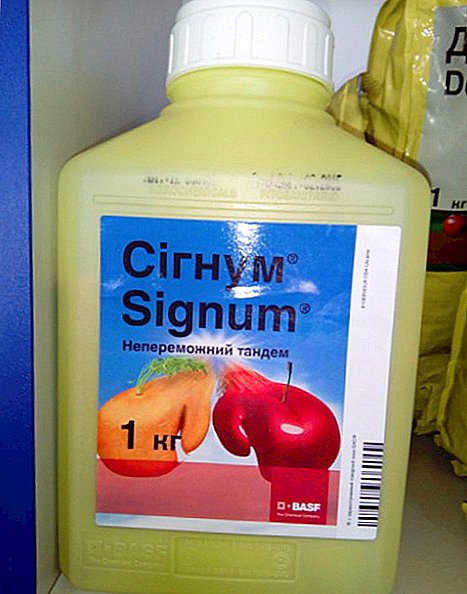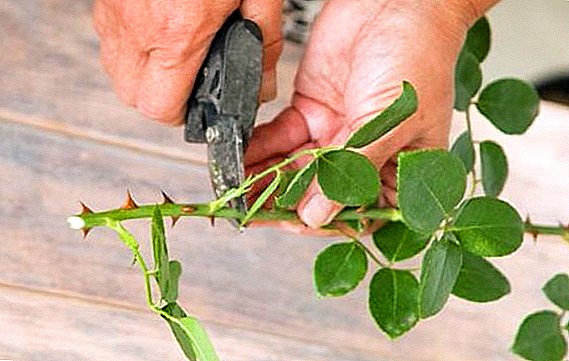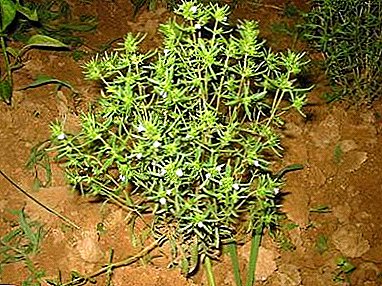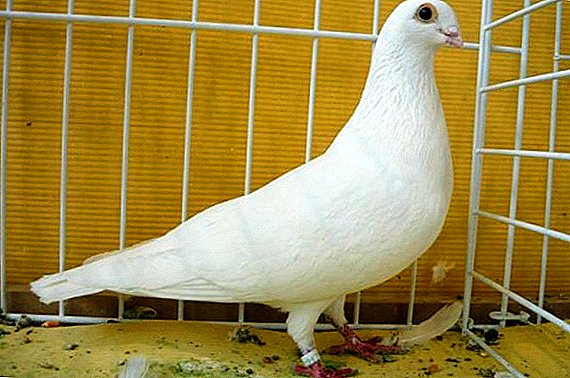 Hungarian high-flying pigeons are the perfect combination of beauty and excellent flight qualities, thanks to which they are so appreciated by many poultry farmers. In addition to these advantages, birds are characterized by low requirements for conditions of detention, so you should learn more about the representatives of this breed.
Hungarian high-flying pigeons are the perfect combination of beauty and excellent flight qualities, thanks to which they are so appreciated by many poultry farmers. In addition to these advantages, birds are characterized by low requirements for conditions of detention, so you should learn more about the representatives of this breed.
Breed history
"Hungarians" is a generalized concept that includes several breeds. From the title it is easy to guess that Hungary is the homeland of these pigeons.  Budapest high-flying pigeons A great contribution to its development was made by the breeders of the city of Chepel, who used then-known Budapest stork pigeons as parent birds. For the first time they were talked about in 1941, although selection work on the breeding of such a universal breed has been going on since the beginning of the 20th century.
Budapest high-flying pigeons A great contribution to its development was made by the breeders of the city of Chepel, who used then-known Budapest stork pigeons as parent birds. For the first time they were talked about in 1941, although selection work on the breeding of such a universal breed has been going on since the beginning of the 20th century.  Chepelsky snow-white vysokoletny thurman
Chepelsky snow-white vysokoletny thurman
External differences
Representatives of this breed are characterized by a fairly simple appearance, without sharp bends and protuberances of the body. All of them are tightly folded, with a "knocked down" body and proportional parts, and does not fit into the overall picture, only a small head with a short beak.
Read also about high-flying breeds of pigeons: Nikolaev, Sverdlovsk.
The main exterior features include the following:
- Head - small, smooth, oval in shape, with a smooth line of the forehead and beak. Eyes - dark brown (sometimes black), bulging, with narrow parchment eyelids.
- Neck - medium length, narrowed up and wider at the base. To the back of the head it is curved.
- Chest - weakly contoured, convex, larger than medium size, with well-defined muscles.
- Back - tapers away from the shoulders, slightly inclined, rather wide.
- Wings - tight to the body, with wide shields. Lay down on both sides of the tail.
- Tail - narrowed, it does not reach the soil line, includes 12 tail feathers.
- Paws - medium, widely spaced and quite powerful, red.
- Plumage color - varies from white to gray-black, with all shades of brown. The head, neck and ends of the wings often have a contrasting color, while white birds have dark blotches. Plumage of a trunk never differs motley.
 There are a number of features that make it possible to attribute some birds to a "marriage". First of all it is:
There are a number of features that make it possible to attribute some birds to a "marriage". First of all it is:
- torso length more than 45 cm;
- accelerated growth;
- body disproportion;
- a large head with a protrusion above the forehead and a break in the line of the beak and forehead;
- white rings around the eyes;
- shortened neck;
- long feathered legs.
Of course, such pigeons are no longer allowed for breeding.
Did you know? In the modern world there are more than 300 breeds of pigeons, but one of the most unusual representatives is the crowned blue pigeon with a refined feather crown on its head. These large birds (about the size of a turkey) are completely different from the usual street pigeons and are found only in New Guinea in the wild.
Conditions of detention
As we have already mentioned, high-flying Hungarians are unpretentious birds. The main thing is to immediately prepare the pigeon house and organize a full-fledged nutritional meal.  The main points that are worth paying attention to include the following:
The main points that are worth paying attention to include the following:
- Room The ideal place is a well ventilated, spacious and bright attic with low humidity. Any drafts should be completely eliminated so that birds do not catch cold. Flight to the street can be arranged through the windows. At 1 pair of birds should be ½-1 cub. m rooms. If you are going to build a large house, then it is advisable to divide the internal space into several sections, 15 bird pairs in each. You can also organize temporary removable partitions in them, so that you can separate the young individuals from their parents or arrange for females and males for a while.
- Window. Their area should occupy 1/10 of the total floor area.
- Ventilation in the dovecote. This is a mandatory element of any room for keeping pigeons. Most often it is the supply and exhaust holes, which make 15 cm from the floor (provides air flow) and under the ceiling (exhaust). Both air vents are closed with a grille, and at the time of cold weather they are supplemented with doors with sliding mechanisms.
- Walking aviary. If you do not plan to let birds fly outside, then such an aviary is obligatory. It is necessary to place boxes of greens in it and to ensure a sufficient inflow of sunlight to create conditions as close as possible to natural.
- Roosting Each bird in the pigeon house should have its own resting place and basis for creating a nest during the breeding season. It is possible to build a perch from 2x4 cm bars, maintaining a distance of about 40 cm from the ceiling (a great option for small representatives of the breed). It is advisable to supplement the nest compartment with 80x40 cm shelves, on which boxes for mating will be installed first, and later the nests themselves (you can use both round and tetrahedral constructions with a height of 7 cm sides).
- Troughs. When the content of the Hungarian high-flying pigeons should be installed separate feeders for grain, greenery and mineral supplements. The sides of the feeders should be about 3-4 cm, so that the bird can easily reach the food. Auto feeders in this case will not work, since the restriction of motor activity in combination with the constant availability of food can lead to obesity of birds.
- Drinkers. They can have the most diverse design, but the most convenient for these birds are considered to be vacuum varieties and auto-drinkers. Do not forget about the individual tanks for swimming birds. For this role, vessels with a wall height of 6-7 cm and a width sufficient for a pigeon will fit perfectly.
- Flooring. The floor of the house is desirable to cover moisture-absorbing material that can reduce the humidity in the room. In winter, such a coating will protect the legs of pigeons from hypothermia. If the floor in the perch is wooden, you can use large sawdust, coarse sand or dry peat as flooring. During nesting, you should additionally stock up with soft straw and thin woody sprigs.



Important! One of the main characteristic features of the Hungarian high-flying pigeons is the poor survival rate in other people's dovecotes. Therefore, when keeping other breeds, these birds will have to organize their own corner.
Pigeon house cleaning and disinfection
After winter, indoors, pigeon houses traditionally carry out general cleaning with full disinfection of the floor surface, perches, nests, feeders and drinkers. At the time of cleaning all birds are transferred to another room or released on the street. Standard cleaning involves the replacement of a layer of flooring, thorough washing of feeders and drinkers (with scalding with boiling water), as well as the replacement of hay in roost. The regularity of such events is once a week.  Complete disinfection of pigeon houses is carried out 1-2 times a year using 3% solution of caustic soda and formaldehyde vapor (veterinarians, who have all the necessary equipment for this, deal with the treatment best of all). Such disinfection allows you to destroy all the parasites that are frequent neighbors of birds in the dovecote. If the concrete floors are indoors, then their surface can be disinfected with a burner, which can be a good floor burner. Also whitewashing of walls with fresh lime is considered to be a good way to disinfect.
Complete disinfection of pigeon houses is carried out 1-2 times a year using 3% solution of caustic soda and formaldehyde vapor (veterinarians, who have all the necessary equipment for this, deal with the treatment best of all). Such disinfection allows you to destroy all the parasites that are frequent neighbors of birds in the dovecote. If the concrete floors are indoors, then their surface can be disinfected with a burner, which can be a good floor burner. Also whitewashing of walls with fresh lime is considered to be a good way to disinfect.
Important! It is advisable to make all shelves, nests and perches inside the pigeon house collapsible so that they can be easily removed during the general cleaning process.
What to feed
Hungarian high flying pigeons are prone to rapid weight gain, therefore light food should prevail in their diet. The main component is usually the grain, and both itself and as part of the feed mixture. It will be useful to add plant seeds, beans, peas, lentils to the menu, but legumes will be relevant only after thoroughly grinding the culture.
You can feed the feathery and apple-dabbed carrots - the mixture is a good source of essential vitamins and valuable amino acids. Sometimes Hungarians give barley, rice, corn, containing a large amount of glucose and sugar. Such food will be especially useful after a long flight.  No less useful for Hungarian pigeons will be potatoes, cabbage and dried bread, which give a little less cereal. For the role of mineral dressings, various greens are perfect, although you can also use ready-made complex dressings. Balanced feeding of birds is especially important during the period of molting and incubation of offspring.
No less useful for Hungarian pigeons will be potatoes, cabbage and dried bread, which give a little less cereal. For the role of mineral dressings, various greens are perfect, although you can also use ready-made complex dressings. Balanced feeding of birds is especially important during the period of molting and incubation of offspring.
The number of feedings and feed each poultry farmer selects independently based on the behavioral characteristics of birds and their vital rhythm.
Learn more about feeding domestic pigeons and pigeons.
Vaccination
Like other breeds of pigeons, the Hungarians are to a certain extent susceptible to standard bird diseases, for example, salmonellosis and Newcastle disease, which means that vaccination will not work. La Sota is considered the most popular vaccine against pseudo-pills (Newcastle disease).
Typically, the drug is injected into the body through an injection injection in the neck, but as a valid alternative, you can bury it in the nose. The action of "La Sota" begins a few days after vaccination and protects the bird for 3 months. This vaccine is completely safe and therefore can be used for Hungarians of any age.  The vaccine against smallpox is used only after vaccination of pigeons from salmonellosis and pseudo-pills, respectively, and after the development of the birds' immunity to these ailments. Usually, pigeons are vaccinated only in those farms where there is an increased risk of infection and there have already been cases of the disease. The vaccine is used only once and is administered only to pigeons older than two months of age.
The vaccine against smallpox is used only after vaccination of pigeons from salmonellosis and pseudo-pills, respectively, and after the development of the birds' immunity to these ailments. Usually, pigeons are vaccinated only in those farms where there is an increased risk of infection and there have already been cases of the disease. The vaccine is used only once and is administered only to pigeons older than two months of age.
The reaction to the drug is usually manifested at 5-8 days after administration and is expressed in small pock marks on the membranes of the wings. A month later, all traces disappear, and the full effect of the vaccine occurs within a week.
Did you know? City pigeons will never be lost even in a multi-million metropolis, because these birds perfectly remember the landscape features of the territory, and they also have the so-called “built-in compass”, which helps them to orient themselves by the sun. Even if they are taken far beyond their usual territory, they will still find their way home.
Video: four high flying pigeons
As you can see, the Hungarian high-flying pigeons are in many ways similar to representatives of other breeds and do not require any specific conditions of detention. With all its beauty, they are very unpretentious, making it suitable for breeding by both experienced poultry farmers and novice amateurs.


